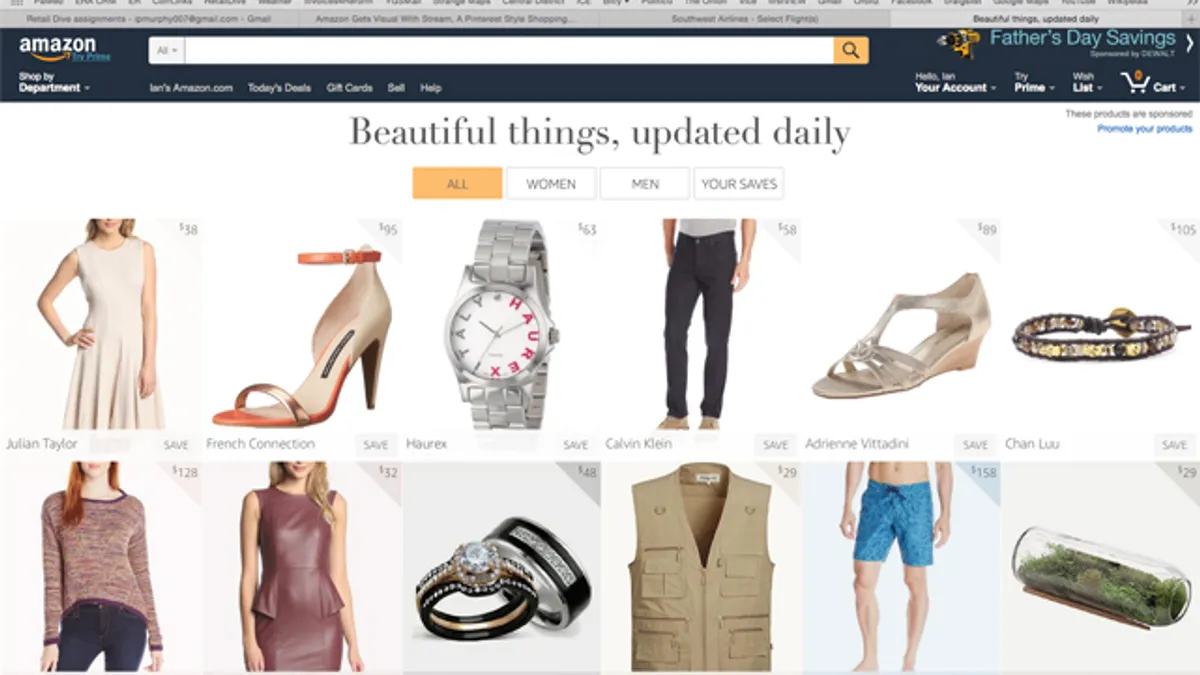Dive Brief:
-
Amazon will soon raise fees for third-party sellers of apparel, accessories, handbags and sunglasses and reduce them for sellers of jewelry, according to digital marketing agency CPC Strategy and Business Insider, which cited research from Instinet. Amazon didn’t immediately return Retail Dive’s request for confirmation or comment.
-
Effective April 15, on goods selling at $75 or higher, fees for sellers in the clothing and accessories category will rise from 15% to 17% and in the handbags and sunglasses category from 15% to 18%. The 15% rate will remain for items under $75, according to the CPC Strategy report.
-
For a limited time, the referral fee will be reduced for jewelry with sellers paying 20% up to $250, plus 5% for any portion greater than $250 with a minimum fee of $2.00 per item, according to CPC Strategy. That new pricing schedule will be in effect Feb. 22 for one year, according to that report.
Dive Insight:
Once in effect, the new pricing policies for third-party sellers in these categories will mean that apparel sellers will have the highest fees on the company’s marketplace compared to sellers in other categories, CPC Strategy said in a blog post. Fulfillment by Amazon fees for all categories is also going up effective Feb. 22, CPC Strategy noted.
The change signals Amazon’s confidence in its own apparel endeavor — which is well founded. More than half (52%) of apparel shoppers who bought clothing online in the last six months said they shopped at Amazon, according to a survey of 1,500 U.S. shoppers released by CPC Strategy earlier this month.
Even CPC Strategy researchers, well aware of Amazon’s command of e-commerce, were caught off guard by its entrenchment in apparel sales, according to CEO and co-founder Rick Backus. "We knew that Amazon dominated most retail verticals," he said in a statement. "But when we saw the survey results, we were pretty surprised that over 50% of shoppers opted to buy apparel most frequently on Amazon in the past six months.”
Since 2016, the e-commerce giant has launched a series of private label clothing and accessories brands in various sub-categories, most recently in footwear. The company is also experimenting with various sales and delivery models, including a new apparel subscription service (currently in beta), Prime Wardrobe.
The fee hikes also demonstrate the conundrum for Amazon's Marketplace sellers, who gravitate to the e-commerce giant for its extensive research, robust search and sticky Prime customers, but who also face competition from Amazon itself and the whims of the company's seller policies.
Those whims have led some sellers to turn elsewhere, notably Walmart, which has demonstrated renewed effort when it comes to its own marketplace. Walmart’s e-commerce marketplace launched in 2009 and is gaining fast, in part because many merchants want to diversify their outlets beyond Amazon, according to eMarketer.
In addition to fee increases in fulfillment and sales, brands and sellers often suffer from Amazon's tendency to capitalize on their success. For example, Amazon Essentials accounted for 4% of its daily best sellers, up from zero a year ago. Its top-performing item was the "Men’s Cotton Pique Polo Shirt," markedly similar to Dockers’ "Men’s Short Sleeve Solid Poly Pique Polo Shirt" at half the price, according to recent research from digital insights firm L2. "With Levi’s/Dockers owning the second highest share of best sellers in the men’s clothing category, this suggests Amazon’s private label brands pose the greatest threat to the very brands that are top of the category today," according to L2.
On Prime Day last year, for the first time, Amazon’s private label brands Mae (lingerie), Goodthreads (men’s dress shirts), Lark & Ro (women’s dresses) and Buttoned Down (men’s dress shirts) landed in Amazon’s best seller rankings in their categories, driven by full-screen visibility on Prime Day’s fashion landing pages, L2 found. In fact, and alarmingly for brands, Amazon’s Fashion landing page on Prime Day this year exclusively featured private label products, the research found. And those private labels maintained much of their momentum after Prime Day.
That’s hardly going to stop. "Amazon’s private label brands were the main beneficiaries of Prime Day, suggesting that in the future there will be fewer opportunities for legacy brands to capitalize on busy Amazon shopping days," L2 said in its report. Brands should expect the holidays to be another time when Amazon promotes its own labels, L2 added.













